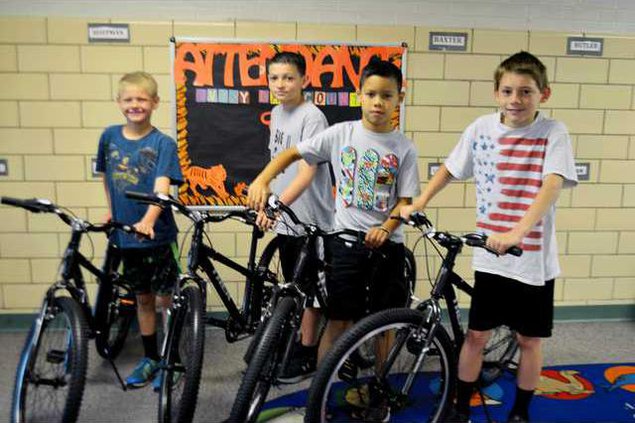For the last day of school on Thursday, Park Elementary instructor Signe Cook wore a T-shirt that read:
Dear parents,
Tag, you’re it.
Love, Teachers.
There was plenty going on for the last day of school. Four bicycles were delivered and given to Park’s four students who had perfect attendance during the 2017-2018 school year: Kevin Richardson, Zac Davis, Ismael Ramirez and Davin Randolph. Funds for the bicycles were donated by several people in the community as a way to encourage attendance, something that is emphasized at Park School, according to Principal Phil Heeke. The four boys posed with their new bikes in front of a display that said, “Attendance: Every Day Counts.”
Elsewhere in the building Thursday morning, fifth-grade teacher Signe Cook was preparing to help students dismantle a science project involving hydroponics. Cook, one of Great Bend USD 428’s two Teachers of the Year for 2017-2018, received a mini-grant from the district Education Foundation to purchase the materials for this project.
“A lot of kids think you need dirt or soil to grow plants but you don’t,” Cook explained. “You just need the minerals.”
In Signe’s classroom, several plastic foam cups were sprouting (or failing to sprout) lettuce leaves. The cups sat on paper plates that were suspended above containers of water.
The Great Bend Tribune interviewed three fifth graders who had taken part in the project, Danielle Hardiman, Marianna Juarez and Laylah Morrison.
“We had to make our own hydroponic system,” Morrison said. Instead of dirt, they had the choice of using vermiculite, perlite or gravel. In addition to tending and observing their plants, the students tested the water’s pH level.
But first, they had to prepare the seeds, Juarez said. They separated 30 seeds and placed a coffee filter on top. After the seeds germinated, they chose the best 20 seedlings, which were planted in the cups. Cotton balls were used as wicks to draw water from separate containers.
The students learned why people might want to grow plants hydroponically, Hardiman said. City dwellers might only have a window sill available for a garden spot, for example. Hydroponics might be used in the desert or even on Mars!
Not every experiment was successful, but the attempts were all educational. Cook said students learned that every plant needs minerals, water and light to grow — and that if one system fails, a project can be re-engineered and tackled again. “This was a good project,” Cook said.





